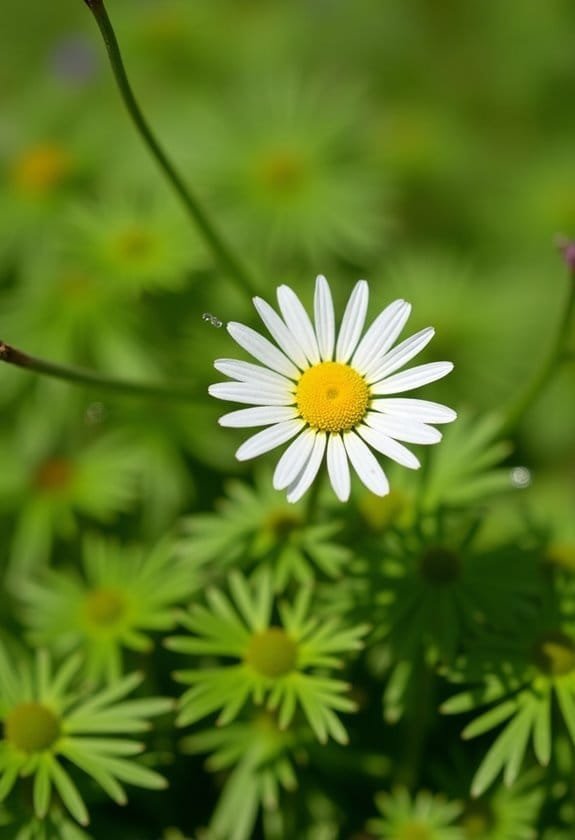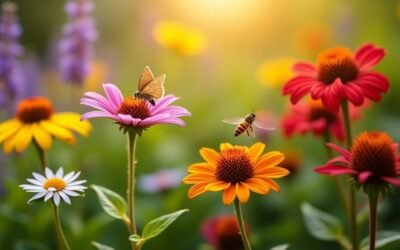Scented Mayweed (Matricaria recutita), also known as German Chamomile, is a versatile herbaceous plant reaching heights of 20-60 cm. It's distinguished by its delicate, feathery leaves and daisy-like flowers with white ray florets surrounding yellow conical disks measuring 10-25 mm in diameter. The plant emits a characteristic apple-like fragrance when crushed and flourishes in well-drained, nitrogen-rich soils with full sun exposure. Blooming from May to September, each plant produces an impressive 5,000-17,000 seeds that remain viable for up to 11 years. This remarkable species' historical significance and modern applications span medicinal, cosmetic, and ecological domains, offering insights into its enduring importance.
Main Points
- Scented Mayweed (Matricaria recutita) is an aromatic herb with white-petaled flowers and yellow centers, growing 20-60 cm tall.
- The plant releases a distinctive apple-like fragrance when its feathery leaves are crushed, aiding in identification.
- Flowering occurs from May to September, with each plant capable of producing up to 17,000 seeds per season.
- Grows best in well-drained, nitrogen-rich soil with full sun exposure and moderate watering requirements.
- Also known as German Chamomile, it serves medicinal purposes and attracts pollinators, particularly bees, during blooming season.
Introduction

Scented Mayweed (Matricaria recutita), a member of the prominent Asteraceae family, stands as one of nature's most versatile medicinal herbs.
The plant's distinctive apple-like fragrance and daisy-like flowers, featuring pristine white petals encircling a golden-yellow disc, make it instantly recognizable in gardens and fields across the globe.
This annual herbaceous species, which reaches heights between 20-60 cm, has earned widespread recognition under various names, including German Chamomile, reflecting its rich history in traditional medicine and cultivation.
Common Name
A plant of many names, German Chamomile stands as the most widely recognized common name for Scented Mayweed (Matricaria chamomilla). This versatile herb's nomenclature reflects its rich heritage, particularly its historical significance in Germanic regions where it has been cultivated for centuries as a medicinal plant.
The descriptive name "Scented Mayweed" eloquently captures one of the plant's most distinctive characteristics: its appealing aromatic profile, which releases apple-like fragrances when its foliage is crushed or disturbed.
In certain localities, the peculiar nickname "Dog" has emerged, though this designation is less common and primarily confined to specific regional dialects.
The plant's scientific classification, Matricaria chamomilla, places it firmly within the Asteraceae family, alongside other daisy-like flowering plants that share similar morphological features.
Its characteristic blooms, comprising white ray florets that radiate from a central yellow disc, make it readily identifiable among related species, contributing to its various common names that often reference these visual attributes.
These multiple appellations reflect the plant's widespread recognition and cultural significance across different regions and traditions.
Scientific Name
The scientific name Matricaria recutita stands as the formal taxonomic designation for Scented Mayweed, reflecting its position within the extensive Asteraceae family. This well-studied medicinal herb carries a name rich in historical significance, as "Matricaria" derives from the Latin word "matrix," acknowledging its traditional applications in women's health treatments.
The binomial nomenclature Matricaria recutita serves as the plant's universal scientific identifier, enabling researchers and practitioners worldwide to communicate precisely about this species without confusion.
While commonly known as German chamomile, the formal classification of Matricaria recutita distinguishes it from similar-looking species within the Asteraceae family, particularly its close relative Roman chamomile (Chamaemelum nobile).
The species epithet "recutita" complements the genus name, creating a complete taxonomic identity that botanical databases and scientific literature consistently reference.
This scientific designation helps researchers track the plant's native distribution across Europe and Western Asia, where it has evolved to display its characteristic white ray florets and yellow central disc, features that contribute to its systematic classification.
Overview
Beyond its scientific classification, Matricaria recutita stands as one of nature's most versatile medicinal plants, widely recognized for its distinctive daisy-like flowers and aromatic presence in gardens worldwide. This elegant herbaceous plant, commonly known as Scented Mayweed, reaches heights between 20-60 centimeters and showcases delicate, feathery foliage that complements its characteristic blooms.
As an aromatic plant with deep historical roots stretching back to the Neolithic period, Scented Mayweed has earned its place in both traditional medicine and modern applications. The plant's flowering period extends from May through September, with peak blossoming occurring during the summer months of June and July.
Throughout this time, its white-petaled flowers, centered by vibrant yellow discs, serve as essential resources for pollinators, particularly bees. Native to Europe and Western Asia, this adaptable species flourishes in various environments, from disturbed soils to cultivated gardens.
Its versatility extends beyond ornamental value, as the plant's compounds contribute considerably to herbal remedies, cosmetic formulations, and aromatherapy treatments, highlighting its enduring importance in human cultivation.
Key Features
Scented Mayweed distinguishes itself with its upright, branched stem that reaches heights between 20 and 60 centimeters, creating an elegant silhouette in fields and gardens.
The plant's feathery leaves arrange themselves alternately along the stem, while its distinctive flower heads showcase white ray florets surrounding a yellow, conical disk measuring 10-25 millimeters in diameter.
During the flowering season, which typically spans from late spring through summer, these daisy-like blooms emit a characteristic apple-like fragrance when crushed, making the plant particularly appealing to pollinators and garden enthusiasts alike.
Growth Size
Among common wildflowers, Matricaria recutita stands out with its distinctive growth pattern, reaching heights between 20-60 cm (8-24 inches). This remarkable Scented Mayweed develops a robust, branched stem system that supports its characteristically feathery foliage and daisy-like blooms throughout the growing season.
The plant's growth size perfectly complements its reproductive capabilities, as each mature specimen can produce an impressive 5,000 to 17,000 seeds. During its peak flowering period from May to September, the plant maintains a manageable yet impactful presence in various landscapes, with ideal blooming occurring during June and July.
The plant's moderate height allows it to thrive alongside other meadow species while still commanding attention with its pristine white ray florets and yellow central disc. Its well-balanced proportions, combining an erect smooth stem with alternately arranged leaves, create an aesthetically pleasing silhouette that enhances its ornamental value.
The plant's size classification places it firmly within the medium-height herbaceous category, making it an ideal candidate for both wild meadows and cultivated gardens.
Appearance
Distinctive features make Matricaria recutita instantly recognizable in the wild, with its finely divided feathery leaves arranged alternately along smooth, branched stems.
These stems rise elegantly to heights between 20 and 60 centimeters, creating an architecturally striking presence in fields and meadows.
The most engaging aspect of Scented Mayweed lies in its characteristic flowerheads, which measure 10-25 millimeters in diameter and showcase a mesmerizing combination of white ray florets surrounding a yellow conical center.
What sets this species apart is its hollow receptacle, a unique structural feature that botanical enthusiasts often use for identification purposes.
Shortly after blooming, the white ray florets begin to turn downward, creating a distinctive drooping appearance that distinguishes it from similar species.
Perhaps the plant's most enchanting attribute is the apple-like scent it releases when its foliage is crushed, earning it its common name.
This aromatic signature, combined with its delicate visual features, makes Scented Mayweed a remarkable example of nature's attention to detail in both form and fragrance.
Flowering Season
Throughout late spring and summer, Matricaria recutita bursts into bloom, displaying its delicate flowers from May through September. The most prolific flowering occurs during June and July, when the Scented Mayweed reaches its peak blooming period, creating a spectacular display of daisy-like blossoms across fields and meadows.
Each flowering cycle spans approximately 50-65 days, enabling the plant to complete multiple blooming sequences within a single growing season. Under ideal conditions, individual plants can produce two to three distinct flowering cycles annually, maximizing their reproductive potential.
The characteristic white ray florets encircle a prominent yellow conical disc, forming an attractive target for various pollinators essential to the plant's reproduction.
Following successful pollination, the flowering season culminates in an impressive seed production phase, occurring 20-35 days after blooming. A single Scented Mayweed plant demonstrates remarkable reproductive efficiency, generating between 5,000 and 17,000 seeds per plant.
This abundant seed production guarantees the species' continued survival and widespread distribution across suitable habitats.
Growing Requirements

Scented Mayweed requires full sun exposure and well-drained soil with high nitrogen content to reach its ideal growth potential of 20-60 cm.
The plant's adaptability to various temperatures allows it to thrive when planted in either autumn or spring, though it demonstrates particular vigor during the warmer months of May through September.
For successful cultivation, the soil should maintain consistent moisture without becoming waterlogged, and gardeners should monitor for common threats like aphids and mildew, which can impede the plant's development in European growing conditions.
Light
For ideal growth, Matricaria recutita demands full sun exposure, requiring 6-8 hours of direct sunlight each day. This light requirement plays a vital role in the plant's development, particularly during its active growing season when energy needs are at their peak.
Scented Mayweed's relationship with sunlight directly influences its flowering cycle, which spans from May through September. During the height of summer, when daylight hours are longest, the plant channels solar energy into producing its characteristic white-petaled blooms, creating a vibrant display that serves as a beacon for pollinators.
The plant's ability to harness sunlight efficiently makes it particularly well-suited to open meadows and garden spaces where shade is minimal.
While the plant can tolerate brief periods of partial shade, insufficient light exposure often results in reduced flowering and potentially weakened stem development.
Gardeners should position Scented Mayweed in locations that receive unobstructed morning to afternoon sun, avoiding areas shadowed by buildings or larger plants that might compete for available light resources.
Soil
Adaptable soil requirements make Matricaria recutita an accommodating garden plant that thrives across various growing conditions. The scented mayweed demonstrates remarkable versatility in its ability to establish itself in different soil types, particularly favoring well-balanced, nitrogenous environments with minimal lime content.
In natural settings, this resilient herb flourishes in sandy to loamy soil conditions, making it a reliable indicator species for loam-based environments. Its preference for well-drained substrates allows it to prosper in disturbed areas and agricultural fields, where it can establish lasting colonies through self-seeding behavior.
The plant's root system efficiently adapts to these soil compositions, enabling it to extract necessary nutrients without demanding specialized amendments.
While scented mayweed shows a clear preference for specific soil characteristics, it maintains impressive flexibility in less-than-ideal conditions. This adaptability has contributed to its widespread distribution across various landscapes, from cultivated gardens to naturalized areas.
Gardeners can successfully grow this versatile plant in most soil types, provided adequate drainage is maintained and excessive lime concentrations are avoided.
Water
Water management plays a significant role in cultivating healthy Matricaria recutita plants, building upon their adaptable soil preferences. These resilient herbs thrive when provided with moderate watering in well-drained soils, striking a careful balance between adequate moisture and prevention of waterlogging.
During the critical germination and early growth phases, consistent moisture levels become particularly essential for establishing robust seedlings that will develop into vigorous plants. While Scented Mayweed demonstrates impressive drought tolerance once established, maintaining regular irrigation practices guarantees optimal development throughout its growing cycle.
The plants require sufficient water to support their daily exposure to 6-8 hours of full sunlight, yet excess moisture must be avoided to prevent the onset of root rot and associated fungal complications.
In nitrogenous, low-lime soils, moisture retention reaches a perfect equilibrium, supporting the plant's hydration needs while facilitating proper drainage. Successful cultivation hinges on observing the soil's moisture levels and adjusting watering frequency accordingly, much like orchestrating a delicate dance between providing necessary hydration and preventing oversaturation.
Temperature
Temperature requirements play an essential role in the successful cultivation of Scented Mayweed, with ideal growth occurring between 15°C and 20°C (59°F to 68°F). During the germination phase, maintaining this ideal temperature range guarantees robust seedling development and establishes a strong foundation for future growth.
Once the plants have matured, Scented Mayweed demonstrates remarkable adaptability to various temperature conditions, though it flourishes best in moderate climates. While the plant can withstand brief cold spells down to -5°C (23°F), prolonged exposure to freezing temperatures may cause significant damage to its delicate tissues.
The plant's resilience is significantly enhanced when it receives adequate sunlight, requiring a minimum of six hours of direct exposure daily to maintain its temperature tolerance.
To support the plant's temperature management capabilities, consistent moisture levels must be maintained throughout the growing season. Like a well-regulated greenhouse, the combination of proper hydration and temperature control creates an environment where Scented Mayweed can thrive, protecting it from both heat stress and cold damage while promoting vigorous growth and abundant blooming.
Pollinator Criteria
Scented Mayweed serves as an essential nectar source for numerous pollinating insects, with bees being particularly drawn to its easily accessible, daisy-like flower structure.
The plant's extended flowering period, which spans from May through September, perfectly aligns with peak pollinator activity seasons, making it an invaluable resource for these beneficial insects.
Its presence often indicates thriving pollinator populations, as the plant attracts not only bees but also butterflies and ladybirds, which contribute greatly to local ecosystem health and biodiversity.
Attracted Pollinators
Vibrant daisy-like flowers of Matricaria recutita serve as beacons for numerous pollinators, particularly bees seeking nectar and pollen. The plant's abundant floral resources create an attractive feeding station for various beneficial insects during the growing season, contributing considerably to local biodiversity.
From May through September, these aromatic blooms maintain a steady presence in disturbed areas and cultivated landscapes, with peak flowering activity occurring during June and July. This extended blooming period guarantees a reliable food source for pollinators when they're most active, creating a mutually beneficial relationship between plant and insect.
The flower's architecture plays a vital role in its pollinator success story. Its open, accessible structure allows insects to easily gather resources, while its visual characteristics act as natural signposts guiding pollinators to their reward.
This efficient pollination system not only guarantees the plant's reproductive success but also supports the surrounding ecosystem by maintaining healthy pollinator populations. Through this intricate relationship, Scented Mayweed demonstrates nature's remarkable ability to create sustainable partnerships between species.
Pollination Method
The pollination process of Matricaria recutita showcases a sophisticated interplay between flower structure and visiting insects. The plant's distinct arrangement of white ray florets surrounding yellow disc florets serves as a highly effective biological beacon, drawing pollinators to its nectar-rich centers.
During peak flowering months of June and July, these visual signals work in concert with the plant's aromatic compounds to maximize pollinator attraction.
The flowers' architecture demonstrates remarkable adaptation for insect pollination, with easily accessible landing platforms that accommodate various pollinator species. As insects move between flowers gathering nectar, they facilitate cross-pollination by transferring pollen grains from one plant to another, greatly enhancing genetic diversity within populations.
This efficient pollination system typically results in impressive seed production, with individual plants capable of generating between 5,000 and 17,000 seeds. The extended blooming period from May through September ensures continuous opportunities for pollination success, while the plant's reliance on diverse insect species helps maintain resilience in different environmental conditions.
This intricate pollination strategy has evolved to optimize reproductive success through reliable insect-mediated pollen transfer.
Care & Maintenance

Successful cultivation of Scented Mayweed starts with selecting a well-drained, nitrogen-rich planting site that receives abundant sunlight throughout the growing season.
Regular maintenance includes keeping the soil consistently moist but not waterlogged, with particular attention to watering during dry spells and monitoring for common pests like aphids.
The plant flourishes when paired with complementary species such as yarrow and chamomile, which share similar growing requirements while attracting beneficial pollinators and natural pest predators.
Planting Tips
For ideal growth and abundant blooms, Scented Mayweed requires well-drained soil and full sun exposure. This adaptable plant thrives in various garden settings, making it an excellent choice for both novice and experienced gardeners who want to establish a reliable flowering herb.
When planting Scented Mayweed, gardeners can choose between spring and autumn sowing, as the plant readily self-seeds for subsequent seasons. Surface sow the seeds while maintaining consistent soil moisture, and apply a light covering to temporarily exclude light until germination occurs. The expected germination rate of 40% suggests planting more seeds than ultimately desired for best coverage.
Regular watering becomes essential during dry periods, particularly as the plants establish themselves and develop their flowering cycles. The plant typically produces blooms two to three times annually, creating waves of delicate, daisy-like flowers throughout the growing season.
To guarantee successful establishment, incorporate crop rotation practices with root vegetables and maintain vigilant monitoring for common issues like aphids and powdery mildew, addressing any problems promptly through mechanical control methods.
Ongoing Care
Maintaining healthy Scented Mayweed requires consistent attention to soil conditions, watering schedules, and pest management throughout the growing season. Regular inspections for aphids and other potential pests should be conducted weekly, with any discovered infestations addressed promptly through mechanical removal or organic treatment methods.
The plant's health depends greatly on proper spacing and adequate environmental conditions. While Scented Mayweed thrives in full sun, it needs moderate watering to prevent both drought stress and waterlogged roots. Gardeners should monitor soil moisture levels regularly, adjusting irrigation based on weather conditions and plant response.
To prevent the aggressive spread of Scented Mayweed and maintain ideal growing conditions, implementing strategic crop rotation practices is essential. Including root crops in the rotation cycle helps manage the plant's growth patterns while promoting soil health.
When the flowering period begins, approximately 50-65 days after initial blooming, careful monitoring guarantees ideal harvest timing for medicinal purposes. This attention to timing and environmental conditions helps maintain the plant's therapeutic properties while preventing uncontrolled spread throughout cultivated areas.
Suggested Companions
Companion planting plays a key role in maximizing Scented Mayweed's growth potential and natural pest resistance. The strategic placement of complementary herbs, particularly basil and dill, creates a protective barrier that naturally deters harmful insects while fostering ideal growing conditions.
Marigolds serve as excellent companions for Scented Mayweed, as they work synergistically to enhance the garden's ecosystem. These vibrant flowers attract beneficial insects that aid in pollination and help maintain a balanced environment by controlling aphid populations.
When planning a companion planting arrangement, it's crucial to maintain proper spacing of at least 12 inches between plants to guarantee adequate air circulation and prevent disease transmission.
To further support these plant partnerships, implementing a consistent mulching regime proves invaluable. A layer of organic mulch around the Scented Mayweed and its companions helps maintain consistent soil moisture levels while suppressing unwanted weed growth.
This practice creates an environment where both the Scented Mayweed and its companion plants can thrive, establishing a harmonious and productive garden space.
What Are the Key Differences Between Cotton Thistle and Scented Mayweed?
Cotton thistle and scented mayweed differ in appearance and habitat. The cotton thistle features spiny leaves and a tall, robust structure, thriving in dry soils, while scented mayweed has delicate, daisy-like flowers and a distinct aroma. Effective cotton thistle plant identification relies on recognizing its silver-green foliage and sharp spines.
Common Issues
Scented Mayweed faces several significant challenges, with aphid infestations posing a particular threat to its development and vigor throughout the growing season.
The plant's susceptibility to fungal diseases, including downy mildew, powdery mildew, and rust, requires vigilant monitoring and prompt treatment, especially in humid European climates.
Management solutions include implementing regular spring and summer tilling practices to prevent seed dispersal, while flame weeding offers an effective alternative for controlling unwanted spread in agricultural settings.
Pests/Diseases
Growers of Scented Mayweed face several significant pest and disease challenges that can compromise plant health. Among the most problematic pests are aphids, which can quickly colonize plants and sap their vigor, potentially serving as vectors for various plant diseases. These tiny insects often cluster on young growth, causing distortion and weakening of the plant's overall structure.
The plant's susceptibility to fungal diseases presents another major concern, with downy mildew and powdery mildew being particularly troublesome in European growing regions. While downy mildew manifests as yellowing leaves and stunted growth patterns that can severely impact crop yields, powdery mildew appears as a characteristic white coating that resembles a dusting of flour on the plant's surface.
Additionally, rust disease poses a significant threat, developing as reddish-brown pustules that act like tiny parasitic drains on the plant's resources.
To combat these challenges, successful cultivation requires implementing extensive management strategies. Regular monitoring for early signs of infestation, combined with proper crop rotation practices, helps minimize the risk of both pest outbreaks and disease occurrence.
Solutions
Addressing common issues with Scented Mayweed requires a multi-faceted approach to pest and disease management. The first line of defense against aphids and other pests involves regular monitoring and strategic application of natural insecticides, which can effectively control infestations before they become severe.
For disease prevention, particularly against downy mildew and powdery mildew, proper spacing between plants guarantees adequate air circulation. Growers should avoid overhead watering techniques, instead opting for ground-level irrigation to keep foliage dry and minimize fungal growth conditions.
To prevent scented mayweed from becoming invasive, implementing a thorough management strategy is essential. This includes incorporating root crops in rotation patterns and performing systematic cultivation during spring and summer months.
Mechanical control methods, such as precise hoeing before seed formation, have proven particularly effective in managing unwanted populations. Additionally, cultivating the soil in darkness can greatly reduce seedling emergence rates, providing an innovative approach to controlling this persistent plant in areas where it's considered undesirable.
Summary

Throughout the European and Western Asian regions, Matricaria recutita, commonly known as Scented Mayweed, stands as a versatile annual herb prized for its medicinal properties. This remarkable plant, reaching heights of 20-60 cm, showcases delicate, feathery leaves and distinctive daisy-like blooms that feature pristine white petals encircling vibrant yellow centers.
The plant's resilience is demonstrated through its impressive seed longevity, maintaining a 73% germination rate even after spending 11 years buried in soil, with a notable half-life of 6.5 years. Scented Mayweed's flowering period extends from May to September, reaching peak abundance during the height of summer in July and August.
While it serves as an invaluable resource for pollinators and contributes to ecosystem diversity, its vigorous growth patterns can occasionally challenge native species in their natural habitats. The plant's adaptability to disturbed areas and cultivated lands has secured its position as both a beneficial medicinal resource and an important contributor to local biodiversity, making it a fascinating subject for botanical study and practical application.


